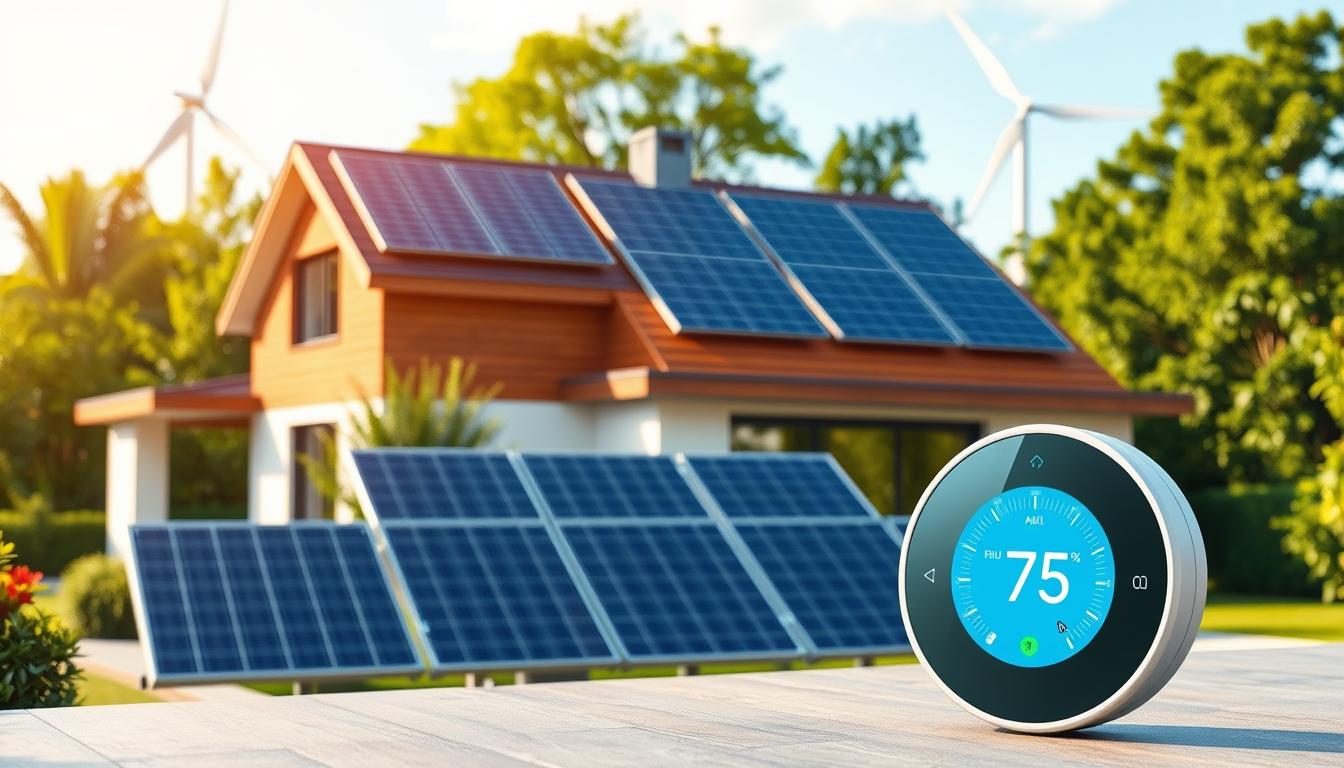Did you know homeowners can get up to $3,200 back in tax credits every year? This makes the cost of making your home more energy-efficient 30% cheaper until 20321. These savings aren’t just a one-time thing. They’re a big reason to upgrade your home’s energy use. By using these incentives, you can save a lot over time. It’s very important for homeowners to know how these credits work. Since these tax credits are here until 2032, putting money into making your home better can pay off. You’ll see real benefits from upgrading your home’s systems and machines. Find out how these savings can make both your wallet and the planet happier.
Key Takeaways
- Homeowners can claim up to $3,200 in federal tax credits annually for energy-efficient upgrades.
- Tax credits cover 30% of eligible expenses, significantly reducing your upgrade costs.
- Investing in energy-efficient home improvements can result in thousands of dollars in savings.
- Credits are available for various eligible upgrades until 2032.
- Understanding these credits is crucial for maximizing your home improvement investment.
Understanding Federal Tax Credits for Energy Efficiency
Federal tax credits offer a big help for those looking to make their homes more energy-efficient. They let you get some of your money back on certain home improvements. This makes upgrading your home more tempting and less pricey. Over time, these credits have grown, helping you save even more on your taxes.
In 2005, the Energy Policy Act let homeowners get back 10% of their costs for some upgrades during 2006 and 2007. This benefit grew to 30% in 2009, but with a cap of $1,500, due to the Emergency Economic Stabilization Act of 20082. More recent laws have made these deals even better. Last year, the Inflation Reduction Act introduced two new credits to encourage green remodeling2.
From the start of 2023, homeowners can get a 30% credit for certain green improvements, up to $1,200. Some upgrades, like installing heat pumps, may get even more back3. Between now and 2032, you could get as much as $3,200 each year for heating and cooling changes. This can greatly cut down your costs4.
Knowing all the different credits helps you make the most of them. You could get yearly credits for big items like new air conditioners or energy-saving windows3. Using these credits means you pay less and help the planet. It’s a win-win for your wallet and the earth.
The Benefits of Energy Efficiency Tax Credits
Energy efficiency tax credits give big benefits to homeowners who want to improve their homes and save money. You can cut your utility bills by making your home more energy-efficient. This leads to great financial incentives. The Inflation Reduction Act of 2022 has increased federal tax credits for being energy-efficient. These credits are available until 2032. For example, you could get up to $300 for installing an ENERGY STAR Most Efficient central air conditioner and another $300 for ENERGY STAR certified air-source heat pumps5.
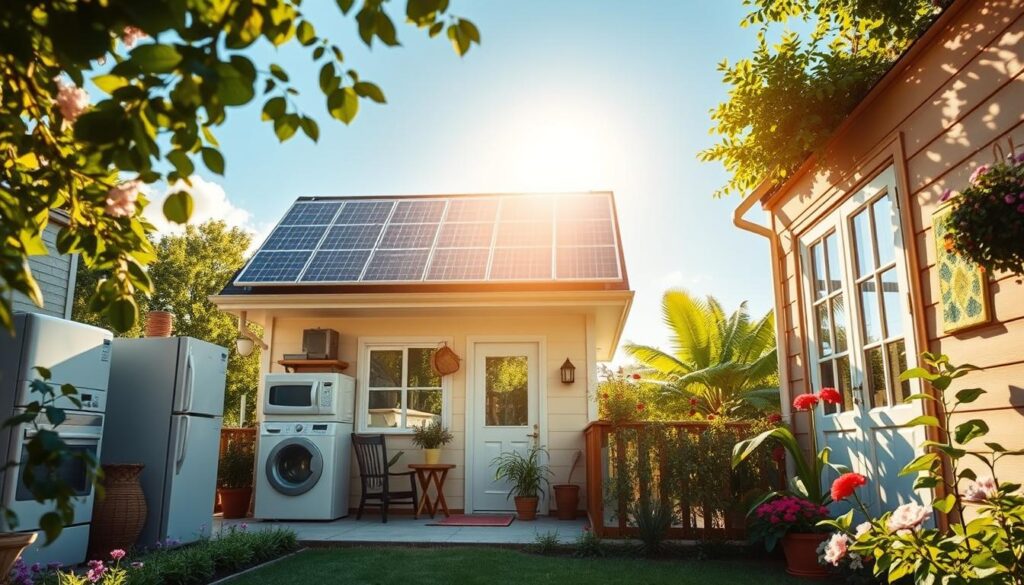
These credits reduce your energy use, leading to long-term savings. Homeowners get a $150 tax credit for ENERGY STAR certified furnaces using natural gas, propane, or oil. There’s also a $50 credit for efficient main air fans5. Moreover, you can choose from a wide range of products eligible for these credits, including insulation, windows, and electric vehicle updates6. This variety ensures incentives are there to support a more eco-friendly life.
| Tax Credit Type | Tax Credit Amount | Eligible Products |
|---|---|---|
| Central Air Conditioning | $300 | ENERGY STAR Most Efficient |
| Air-Source Heat Pumps | $300 | ENERGY STAR Certified |
| Natural Gas, Propane, Oil Furnaces | $150 | ENERGY STAR Certified |
| Main Air Circulating Fans | $50 | Advanced Models |
| Heat Pump Water Heaters | $300 | ENERGY STAR Certified |
| Windows, Doors, Skylights | 10% (up to $200 for windows/skylights, $500 for doors) | ENERGY STAR labeled |
| Bulk Insulation | 10% (up to $500) | Typical Products |
Using these tax credits lets you choose wisely and improve your home’s energy efficiency. This doesn’t just make your home nicer, but it also helps the environment5.
What Are the Federal Tax Credits Available Through 2032?
Homeowners have access to several federal tax credits until 2032. These incentives promote energy-efficient improvements. One key program is the Energy Efficient Home Improvement Credit. You can claim 30% of the cost, up to $3,200 yearly until 20327. There’s also the Residential Clean Energy Credit. It offers 30% off the cost for renewable systems, like solar panels, until 20327.
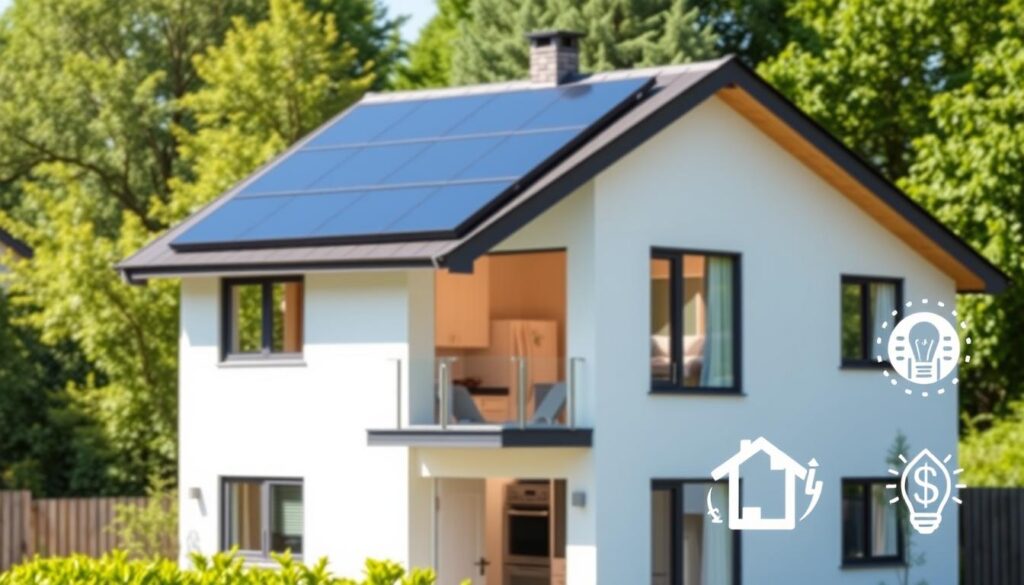
For HVAC improvements, you could get up to $2,000 each year for certain upgrades. This includes air source heat pumps87. Also, efficient air conditioners offer a $300 credit in 2022. After that, it’s 30% of the cost through 20328. Plus, insulation materials get a boost. The credit grows from 10% in 2022 to 30% by 20328.
Additionally, a yearly limit of $1,200 is set for some upgrades87. Yet, by mixing different improvements, some can still max out this cap. This makes upgrading to a greener home both rewarding and eco-friendly.
How the Tax Credits Work for Homeowners
Understanding tax credits is key for homeowners wanting to make their homes energy efficient. The Energy Efficient Home Improvement Credit lets you get back 30% of what you spend on eligible upgrades from the 2023 tax year9.
For those adding things like new windows, heat pumps, or solar panels, there’s now a max credit of $1,200 each year9. This increase helps homeowners save more by using these credits for energy-efficient changes.
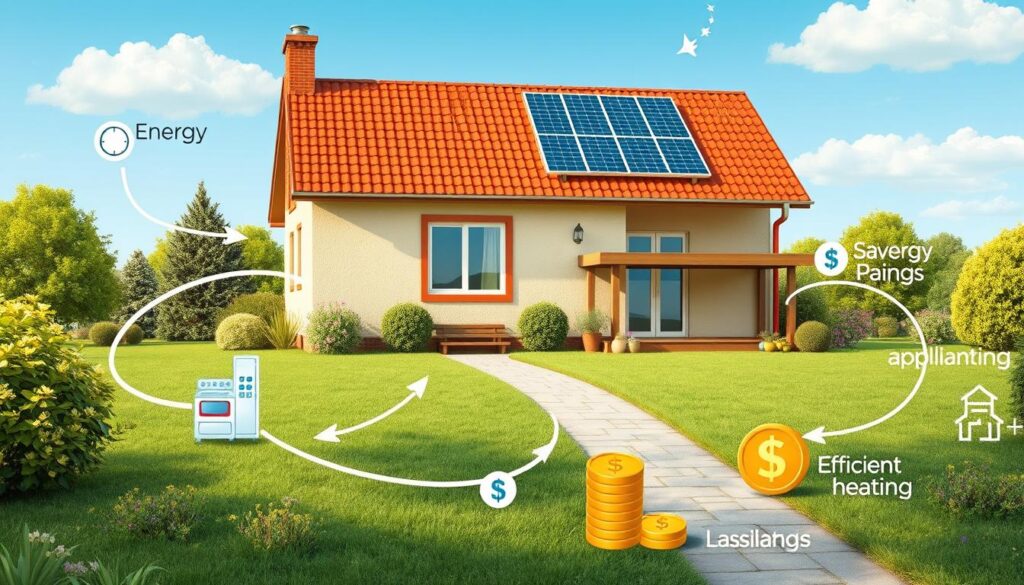
The Residential Clean Energy Credit now extends through 2034, offering a 30% credit for clean energy installs10. With the Inflation Reduction Act, you could get rebates over $10,000 for making your home better10.
Claiming these credits is done through Form 5695 when you do your taxes. This can cut down your taxable income a lot by covering costs of accepted upgrades. It reduces what you owe to the IRS, turning home improvements into a smart money move.
Claiming Your Federal Tax Credits
Getting your federal tax credits takes careful planning. You need to fill out IRS Form 5695 with your tax papers. This form shows the energy-saving updates you did. It’s key to keep all papers like receipts and contractor info, just in case the IRS checks. These credits only count for upgrades at your main home.
Federal tax credits can cover 30% of costs for certain energy improvements. Solar panel systems get this 30% credit for work done from 2022 to 2032. There’s no limit to the credit amount for residential solar energy, which is great for those who qualify11. The solar tax credit amount might vary, especially if your property is used for more than just living.

Energy upgrades like better insulation, new windows, and doors can get up to 30% back in credits, with set limits for each item12. Even home energy checks can get a credit up to $150. It’s wise to talk to experts who can help you understand these credits.
The updated Energy Efficient Home Improvement Credit offers up to $1,200 each year for certain items added from January 1, 2023, to January 1, 203313. This change boosts your possible savings. Knowing your improvements and the credit caps helps you save more on taxes.
| Tax Credit Type | Max Credit Percentage | Annual Limit |
|---|---|---|
| Residential Solar Energy Credit | 30% | No maximum |
| Energy Efficient Home Improvement Credit | Up to 30% | $1,200 |
| Home Energy Audit Credit | 30% | $150 |
How to Claim the Federal Tax Credits
If you plan to claim federal tax credits for energy-smart home improvements, you need IRS Form 5695. This form is key for outlining the Energy Efficient Home Improvement Credit and the Residential Clean Energy Credit. It requires you to report your total qualified expenses accurately.
To make the claim process easy, understanding the eligibility rules is crucial for homeowners. This ensures smooth sailing in claiming the tax credits.
Using IRS Form 5695
To claim your energy-efficient home improvement credits, IRS Form 5695 is a must. You will list the upgrades and their costs on this form. This will help you get the correct credit percentages. Make sure to submit it with your federal tax return.
Filling out the form accurately is vital to streamline your claim. You might need to check the IRS guidelines or get help from a tax expert to prevent errors.
Eligibility Requirements for Claiming
Your chance to claim federal tax credits hinges on if the home is your main living place. The house must be in the U.S. and not for rent. If you or relatives don’t live there, you can’t get the credits. It’s vital to meet these criteria.
These tax credits aim to help homeowners doing eligible upgrades. Such improvements should boost the home’s energy use. Meeting these conditions means avoiding issues when claiming credits.
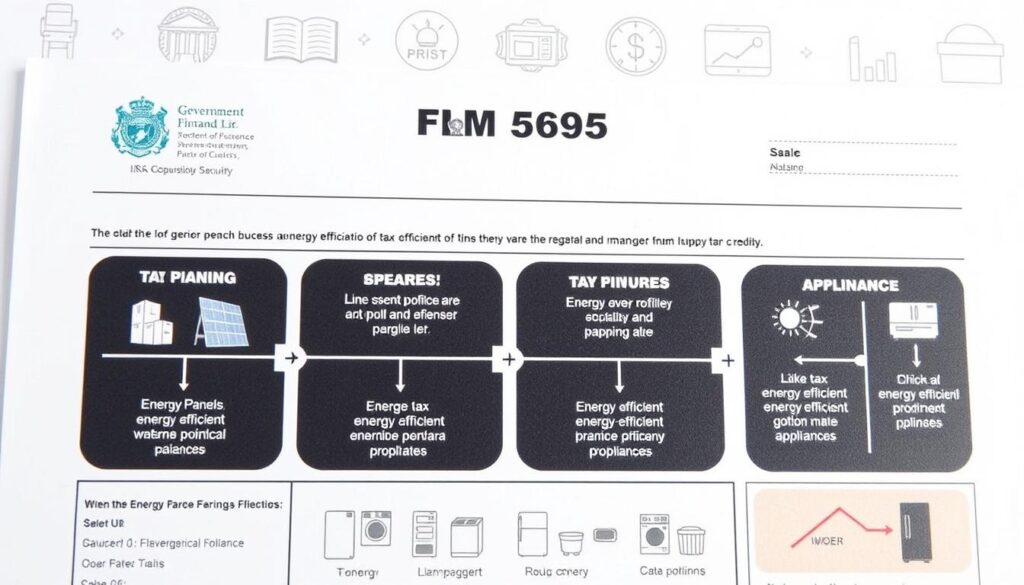
Maximizing Your Savings with Efficient Home Upgrades
Working on energy-efficient home upgrades can really save you money. To get the most out of your tax savings, use different credits. For instance, you can use the Energy Efficient Home Improvement Credit. This lets you get back 30% of what you spend on qualifying improvements until 2032. You can claim up to $1,200 every year for various projects14.
Especially, technologies like heat pumps can offer even more benefits. They allow a higher credit limit of $2,000. This means even bigger savings14.
Combining Different Credits
When you mix different credits for home upgrades, you boost your savings. Over 2.3 million families have already saved more than $2 billion with the Energy Efficient Home Improvement Credit. On average, each family saved $88015. If you do things like installing energy-efficient windows and better insulation in the same year, you can use these credits to their full potential15. This motivates homeowners to plan more upgrades that qualify.
Planning Your Upgrades Over Multiple Years
If you plan your home improvements over a few years, you can save even more. Say, you put in a heat pump one year and improve your insulation the next. You increase your chances of getting the maximum credit every year14. Making your home more energy-efficient can also lower your utility bills. This supports the national goals for clean energy set by the Biden-Harris Administration. It makes for a all-around strategy for home improvement15.

| Type of Improvement | Applicable Credits | Max Annual Credit | Eligibility |
|---|---|---|---|
| Heat Pumps | Energy Efficient Home Improvement Credit | $2,000 | Upgraded efficiency |
| Insulation | Energy Efficient Home Improvement Credit | $1,200 | Qualifying materials |
| Windows | Energy Efficient Home Improvement Credit | $1,200 | Energy Star rated |
| Residential Clean Energy Systems | Residential Clean Energy Credit | No max limit | Qualifying systems |
Planning your energy-efficient upgrades carefully helps your wallet and improves your home. By spreading out your upgrades and using tax credits, you can change your home for the better. All while getting the biggest tax savings possible16.
Financial Benefits of Energy Efficiency Home Improvements
Investing in energy-efficient home improvements brings big financial benefits. Understanding the costs and energy savings helps you make smart choices. Lower utility bills mean more money for your budget planning, raising the value of your investment.
Understanding Costs and Savings
Upfront costs for green upgrades can vary a lot. Homeowners can get a tax credit of 30% for some energy-saving updates, up to $1,200 yearly. They can also get a $2,000 credit for specific heat devices17. These incentives lower the initial costs, making the investment’s financial sense clearer.
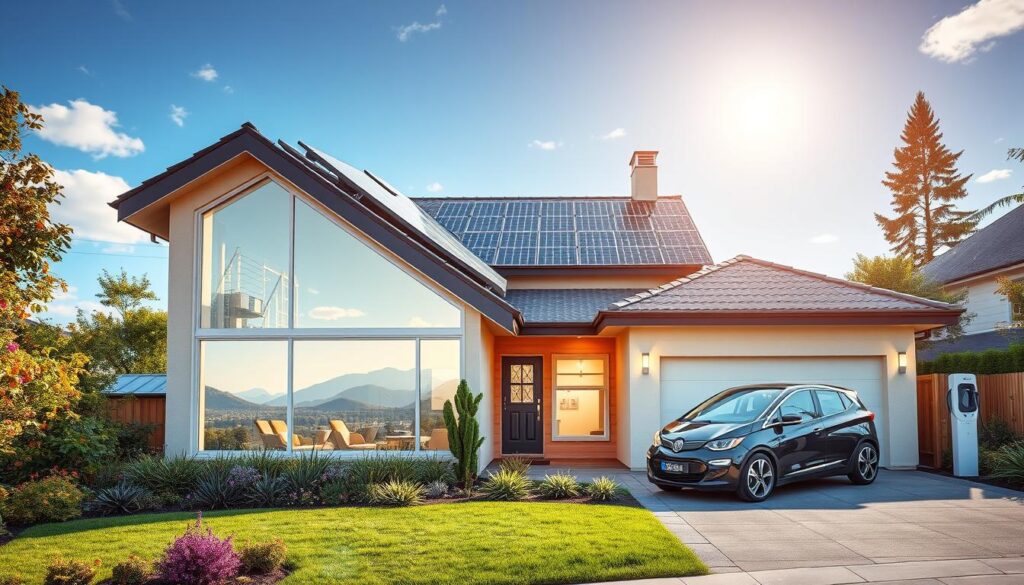
Looking at the long-term return on investment (ROI), energy-efficient upgrades often give good paybacks. For instance, solar panels can pay for themselves in five to 15 years17. Figuring out the ROI means comparing costs with the energy savings and value boosts they bring.
Long-Term Return on Investment
Smart energy-efficient home upgrades have big long-term perks. Though they cost more at first, the savings on energy bills can outweigh these costs. Plus, federal tax credits can give up to $8,000 for retrofitting and $14,000 for new electric appliances17. Extra rebates for some households mean even bigger savings.
Rebates, tax credits, and long-term savings make energy-efficient improvements a smart move financially. With careful planning, these investments yield both immediate and long-lasting benefits. This includes lower energy costs and boosted property values.
Qualified Energy Efficiency Home Improvements
Looking into energy efficiency upgrades for your home? You can get big tax credits. The IRS acknowledges various installations like new windows, insulation, and heating and cooling systems.
It’s important to know if you’re eligible for these credits. You can get back 30% of what you spend, up to $600 for certain items18. For a year, you could get as much as $3,200 back for making your home greener.
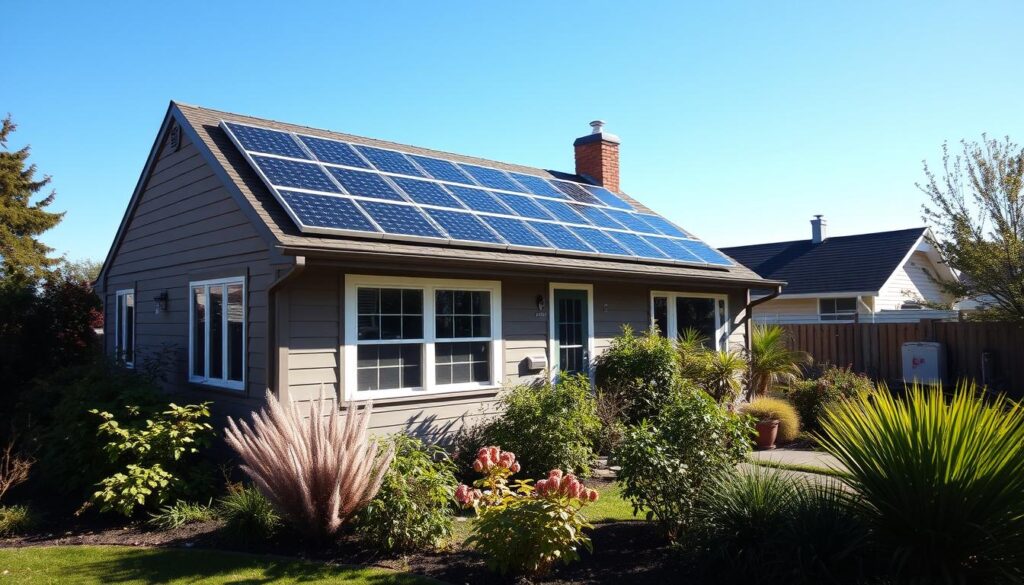
There are different caps for specific upgrades. Adding things like better windows or a new heater could get you up to $1,20019. Heat pumps and similar technologies could net you $2,000 each year.
Easier updates like adding insulation or sealing leaks qualify, too. With the right products, you can get credits. These not only save energy but help with the costs of putting them in.
These tax breaks are for your main home, not new builds or rentals. Plan well, like insulating your attic before getting a new heat pump. That way, you could get the full $1,200 for insulation and $2,000 for the pump19.
Mixing different improvements can lead to more savings. For example, installing a heat pump and replacing windows could give you up to $2,000 for the pump. Plus, you’ll get extra credits for the windows and doors19.
To wrap it up, making these qualified upgrades improves your home and offers great tax credits.
Strategies to Maximize Your Federal Tax Savings
To save on federal taxes through energy efficiency, knowing the right strategies for savings is key. Plan your home improvement projects well to grab the full benefit of tax credits. The Residential Clean Energy Credit offers a big 30% tax credit for buying clean energy equipment. This credit is available through 2032, then it starts to decrease20.
Knowing what each credit offers helps make smarter upgrade choices. The High-Efficiency Electric Home Rebate Program, for instance, gives rebates based on income. It covers up to 100% of costs for those with lower incomes20. Choose experienced contractors for energy-efficient installations. This makes sure you get the credits you’re eligible for, saving more now and later.
Joining the Efficiency Rebates Program could let homeowners get up to $4,000 for making their homes more efficient21. Mixing different incentives and investing in technology like heat pumps can save a lot of energy. This also helps secure the most tax credits possible.
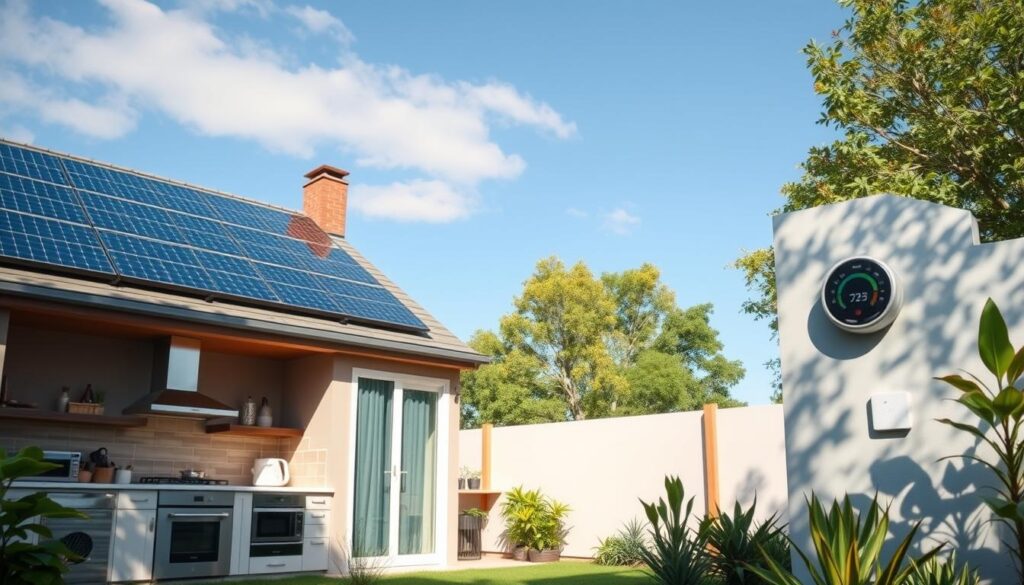
| Program Name | Type of Rebate/Credit | Amount |
|---|---|---|
| Residential Clean Energy Credit | Tax Credit | 30% of costs |
| High-Efficiency Electric Home Rebate | Rebate | Up to 100% of costs |
| Efficiency Rebates Program | Rebate | Up to $4,000 |
| Energy Star New Homes Credit | Tax Credit | $2,500 |
| Qualified Commercial Clean Vehicles Credit | Tax Credit | Up to $7,500 |
Choosing wisely from the programs available can really help your finances while also making your home more green. With all the options out there, now’s the time to take steps towards saving and sustainable living.
Common Energy Efficiency Home Improvement Options
Looking to make your home more energy-efficient? There are several key upgrades that help. These changes can lower your energy bills and might even offer tax breaks. Heat pumps are especially popular for their heating and cooling capabilities.
Heat Pumps and Their Tax Benefits
Heat pumps can get you notable tax breaks under federal energy efficiency credits. If you install a qualifying system, you can claim up to 30% of the cost. This can go up to $2,00022. So, heat pumps not only reduce energy use but also offer financial perks.
Energy Audits: Why They Matter
An important step for better energy use is getting a home energy audit. These audits tell you how you’re using energy and where you can improve. They might even get you a tax credit, up to $15023. Energy audits uncover hidden inefficiencies, guiding you to make smart updates.

Exploring energy-efficient home improvements is wise. It enhances how your home uses energy. Plus, it lines up with government rewards, offering both environmental and financial benefits24.
Federal Tax Credits for Energy Efficiency
Federal tax credits for energy efficiency are a great chance for homeowners to upgrade sustainably. You can get a tax credit worth 30% of your expenses, up to $600 yearly for eligible home improvements18. There are also rebates from various federal programs for more savings. For example, Home Efficiency Rebates offer up to $8,000 for major energy reduction projects18.
Specific appliances like ENERGY STAR-certified electric heat pump clothes dryers could get rebates up to $84018. These dryers use 20% less energy than standard ones. Heat pump dryers can save even more, from 20-60%18. Considering a kitchen update? Electric stoves are three times more efficient than gas ones and can also get up to $840 in rebates18. Making these upgrades lowers your bills and lessens your environmental impact.
Tax credits for heat pumps cover 30% of installation costs. Installed after January 1, 2023, you could get up to $3,200 in tax credits25. This motivates homeowners to improve energy efficiency. The credit is for energy properties like heat pumps, water heaters, and energy audits, which might get up to $150 in tax credits25.
With rising energy costs and growing environmental concerns, using federal tax credits can bring you big savings. Making your home more energy-efficient not only adds modern technologies but also supports a greener future.
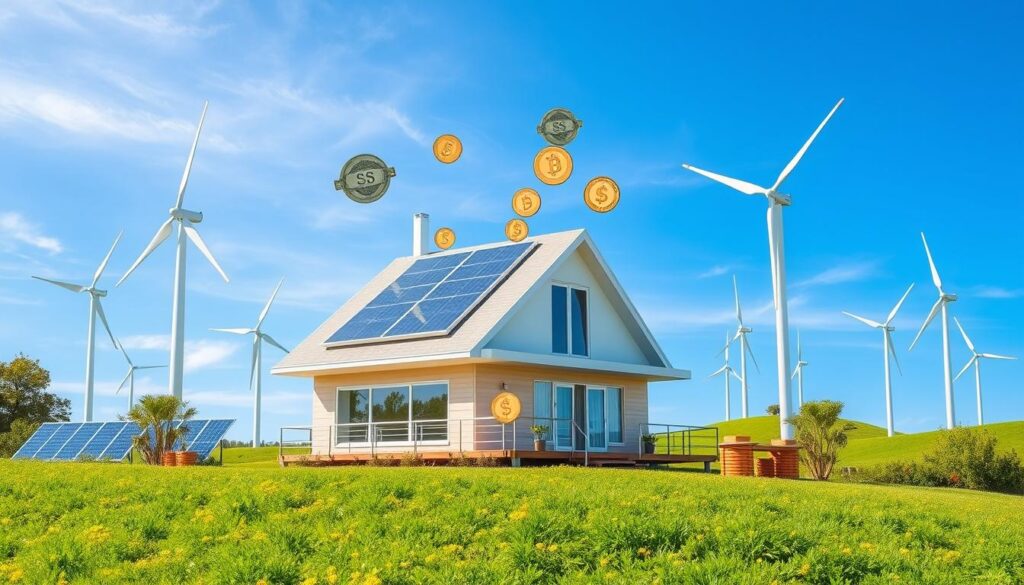
Conclusion
Federal tax credits for energy efficiency can significantly save money for homeowners. They also promote sustainable living. There are many programs that encourage people to upgrade things like heating and cooling systems. By using these tax credits for home improvements, your home’s energy use can drop. This not only cuts down on energy bills but also offers tax benefits until 2032 and further.
Since 2006, homeowners have saved about $42 billion with federal tax credit programs. These savings come from investing in things like solar panels and better HVAC systems26. These improvements don’t just save money through tax breaks. They also boost your home’s value, making it more appealing to buyers27.
It’s important to keep up with federal incentives as they change. Staying informed about what upgrades are eligible can result in big savings. Making these energy-efficient changes benefits your wallet and the planet28.
FAQ
What are federal tax credits for energy efficiency?
How much can I save with these tax credits?
What improvements qualify for federal tax credits?
How do I claim these federal tax credits?
What are the eligibility requirements for claiming these credits?
Can I combine different tax credits for maximum savings?
What is the importance of a home energy audit?
How do these energy-efficient upgrades impact my home’s value?
Source Links
- Federal Tax Credits for Energy Efficiency – https://www.energystar.gov/about/federal-tax-credits
- Tax Credit Information – https://www.energystar.gov/about/federal-tax-credits/tax-credit-information
- Energy Tax Credit: What It Is, How It Works, and Types – https://www.investopedia.com/terms/e/energy-tax-credit.asp
- Understanding energy efficient tax credits – https://tax.thomsonreuters.com/blog/understanding-energy-efficient-tax-credits/
- The Tax Credits for Energy Efficient Upgrades are Back! – https://www.energystar.gov/products/ask-the-experts/tax-credits-energy-efficient-upgrades-are-back
- The Homeowners’ Guide to Tax Credits and Rebates – https://www.constellation.com/energy-101/homeowners-guide-tax-credits-and-rebates.html
- Learn About Federal Tax Credits for Energy Efficiency – Trane® – https://www.trane.com/residential/en/resources/blog/federal-tax-credits-energy-efficiency/
- PDF – https://www.energy.gov/sites/default/files/2023-02/Tax Credit Table.pdf
- Save More with Tax Credits for Energy-Efficient Home Improvements – https://www.kiplinger.com/taxes/605069/inflation-reduction-act-tax-credits-energy-efficient-home-improvements
- Tax Credits for Homeowners: What You Need To Know – https://www.investopedia.com/tax-credits-for-homeowners-what-you-need-to-know-6500550
- Homeowner’s Guide to the Federal Tax Credit for Solar Photovoltaics – https://www.energy.gov/eere/solar/homeowners-guide-federal-tax-credit-solar-photovoltaics
- Making Our Homes More Efficient: Clean Energy Tax Credits for Consumers – https://www.energy.gov/policy/articles/making-our-homes-more-efficient-clean-energy-tax-credits-consumers
- Energy Tax Credit: Which Home Improvements Qualify? – https://turbotax.intuit.com/tax-tips/home-ownership/energy-tax-credit-which-home-improvements-qualify/L5rZH56ex
- Federal Tax Credits for Energy-Efficient Home Upgrades: A Guide for Homeowners — Lender Express Mortgage – https://lenderexpressmortgage.com/blog/federal-tax-credits-for-energy-efficient-home-upgrades-a-guide-for-homeowners/
- DOE Announces New Tools Making it Easier for Home Contractors to Install Energy Saving Appliances and Lower Costs – https://www.energy.gov/articles/doe-announces-new-tools-making-it-easier-home-contractors-install-energy-saving-appliances
- Energy Efficient Upgrades: A Guide to IRA 25C Federal Tax Credits – https://homecomfortalliance.com/blog/news/energy-efficiency/guide-to-tax-credits/
- Home Improvement Tax Credits and Rebates for Energy Efficiency in 2025 – NerdWallet – https://www.nerdwallet.com/article/mortgages/tax-credits-eco-friendly-remodels
- Home Upgrades – https://www.energy.gov/save/home-upgrades
- Insulation Tax Credit – https://www.energystar.gov/about/federal-tax-credits/insulation
- Board of Public Utilities | Customer – https://www.nj.gov/bpu/assistance/incentives/
- Save money with home energy efficiency tax credits – https://www.michiganlcv.org/save-money-with-home-energy-efficiency-tax-credits/
- Energy Incentives for Individuals: Residential Property Updated Questions and Answers – https://www.irs.gov/newsroom/energy-incentives-for-individuals-residential-property-updated-questions-and-answers
- Energy Efficient Home Improvement Credit Insulation and Air Sealing Essentials – https://www.energy.gov/eere/buildings/articles/energy-efficient-home-improvement-credit-insulation-and-air-sealing
- New and enhanced energy tax credits for individuals – https://www.journalofaccountancy.com/issues/2024/nov/new-and-enhanced-energy-tax-credits-for-individuals.html
- Energy Efficient Home Improvement Credit – https://www.irs.gov/credits-deductions/energy-efficient-home-improvement-credit
- Wealthier homeowners nab billions in tax credits for energy efficiency – https://www.eenews.net/articles/wealthy-homeowners-nab-billions-in-tax-credits-for-energy-efficiency/
- 2023 Federal Tax Credits for Energy Efficiency Explained – https://callrandazzo.com/blog/increase-your-savings-while-combatting-climate-change-with-help-from-the-2023-federal-tax-credits-for-energy-efficient-heating-and-cooling-equipment/
- Save on Taxes with Federal Energy Saving Credits – https://lslcpas.com/save-on-taxes-with-federal-energy-saving-credits/
